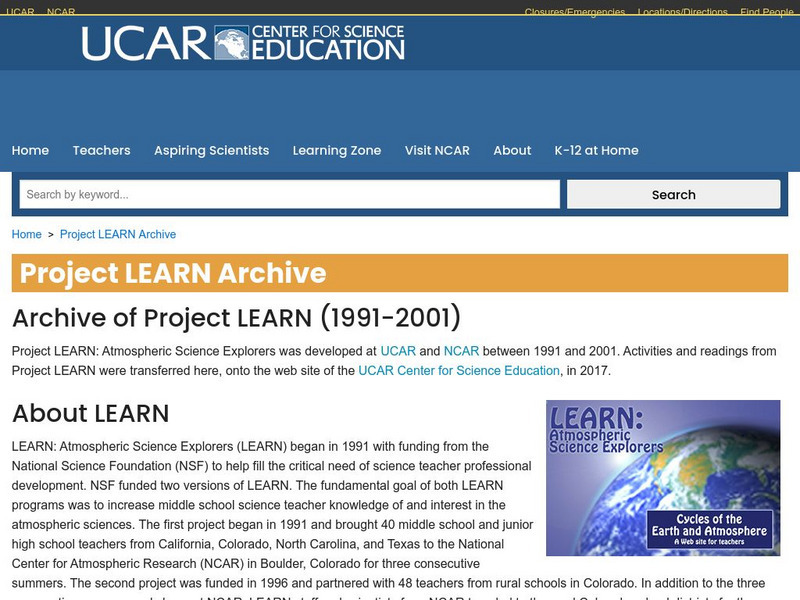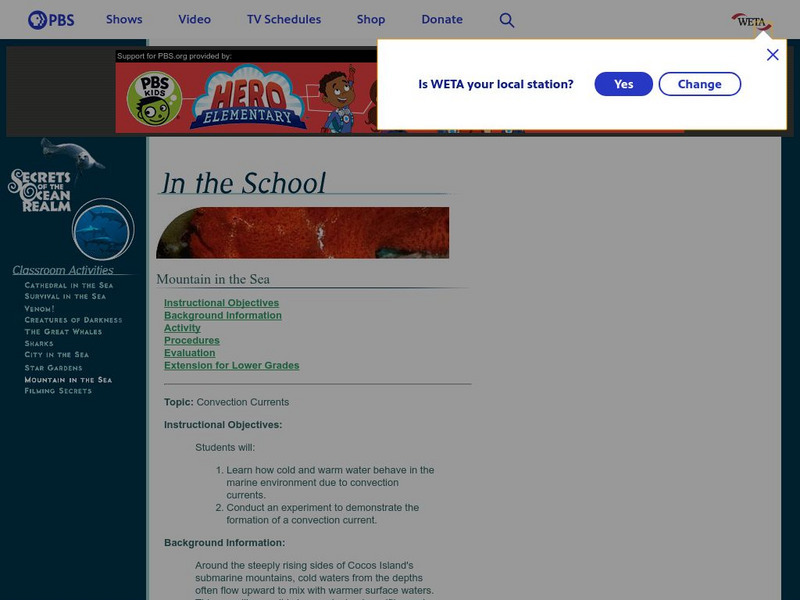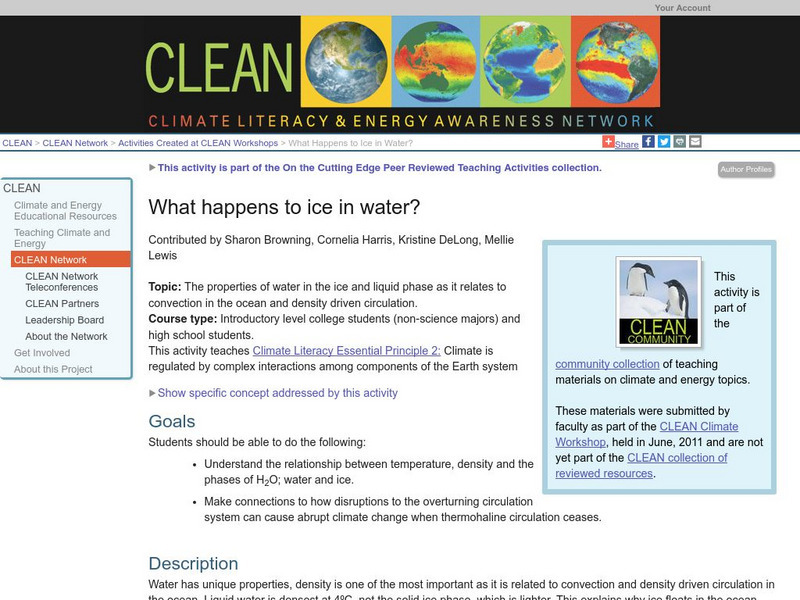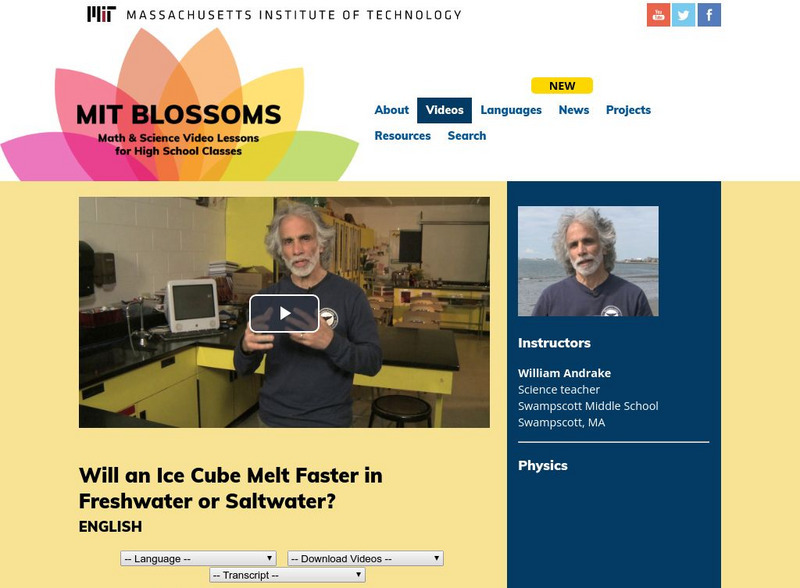University Corporation for Atmospheric Research
Ucar: Web Weather for Kids: Thunderstorms & Tornadoes Make Convection Currents
Demonstrate convection currents using a clear box, red food coloring, ice cubes, colored pencils and index cards. Get all the directions you need for this simple lab.
Exploratorium
Exploratorium: Science Snacks: Convection Current
This lesson plan is a great way to show convection currents in water. Students will see what happens to water as it gets warmed.
Exploratorium
Exploratorium: Science Snacks: Convection Currents
Get a visual of convention currents with this activity. This activity allows students to observe the currents by bending light due to cold and warm water.
PBS
Pbs Kids: Colored Water Convection
This PBS site allows users to learn more about water convection as they discover how to demonstrate the way convection currents form. A fun science project!
University Corporation for Atmospheric Research
Ucar: Atmospheric Processes: Convection
This site provides a pair of activities to demonstrate convection currents in air and water. Encourages students to view air as a fluid.
University Corporation for Atmospheric Research
Ucar: Cycles of the Earth System: Make Convection Currents!
In this lesson, students will understand that temperature changes can cause density changes in water and in air.
Texas Education Agency
Texas Gateway: The Sun and Convection Currents
Learn about the sun's energy, Coriolis effect, and how wind is formed in this interactive learning module.
Exploratorium
Exploratorium: Science Snacks: Pie Pan Convection
In this experiment, students observe what happens when a pan of soapy, colored water is heated. They will see that convection currents cause the fluid to rise and sink in a localized convection cell.
Science Struck
Science Struck: Examples of Convection
Gives lots of examples of convection and instructions for a simple experiment that looks at convection currents in a fluid.
Exploratorium
Exploratorium: Exhibit Cross Reference: Convection Currents
A description of a museum exhibit that illustrates convection and convection currents. Great idea stimulus for a student project or lab investigation.
Utah Education Network
Uen: Investigating Convection
Students will plan and conduct an experiment that investigates convection currents.
Science Education Resource Center at Carleton College
Serc: Mn Step: What Makes Thunderstorms? See Convection
Using water, food coloring, and an ice cube, students observe the movement of convection currents in a container, and illustrate what they see happening. This activity develops their understanding of how thunderstorms form.
Other
Steve Spangler Science: Denver's Brown Cloud
Learn how fluids move through our atmosphere and water. This experiment explains atmospheric convection currents (thunderstorms), the Gulf Stream, and temperature inversion. A video is included.
TeachEngineering
Teach Engineering: Turning the Air Upside Down
Students develop their understanding of air convection currents and temperature inversions by constructing and observing simple models.
Science Buddies
Science Buddies: Ocean Currents: Modeling 'Global Conveyor Belt' in Your Kitchen
Ocean currents have a profound effect on the climates of the continents, especially those regions bordering on the ocean. The Gulf Stream makes northwest Europe much more temperate than any other region at the same latitude, and the...
Museum of Science
Museum of Science and Industry: Activities: Fly a Hot Air Balloon
Step-by-step instructions, with photos, of how to construct a hot-air balloon from tissue paper, to demonstrate that heated air expands, creating a convection current. This activity requires the use of a hot air gun and is labor-intensive.
University Corporation for Atmospheric Research
Ucar: Climate Discovery Teacher's Guide: Investigating Climate Present
Lesson plans on the following: Carbon cycle: Carbon Dioxide Sources and Sinks, Nitrogen Cycle: Traveling Nitrogen, Ocean and Atmosphere: Make Convection Currents, Energy Cycle: Albedo
US Geological Survey
Usgs: Unanswered Questions
Discover how convection currents in the mantle are the driving force of continental drift. The reading also briefly addresses the scientists who laid the groundwork for this idea.
TeachEngineering
Teach Engineering: Let's Get Breezy!
Students apply an understanding of the concept of heat transfer through convection, conduction, and radiation as they use wireless temperature probes to investigate the heating capacity of different materials under heat lamps.
TeachEngineering
Teach Engineering: Weather Watchers
Students are introduced to some essential meteorology concepts so they more fully understand the impact of meteorological activity on air pollution control and prevention. First, they develop an understanding of the magnitude and...
PBS
Pbs, Secrets of the Ocean Realm: Mountain in the Sea
This experiment allows your students to study the effect of temperature on water motion and also to create their own density driven current.
TeachEngineering
Teach Engineering: Air Pollution
Students are introduced to the concept of air quality by investigating the composition, properties, atmospheric layers and everyday importance of air. They explore the sources and effects of visible and invisible air pollution. By...
Climate Literacy
Clean: What Happens to Ice in Water?
Young scholars investigate the properties of water in the ice and liquid phase as it relates to convection in the ocean and density driven circulation, and ultimately the climate.
Massachusetts Institute of Technology
Mit: Blossoms: Will an Ice Cube Melt Faster in Freshwater or Saltwater?
Engage young scholars in the study of the ocean and saltwater with these activities. Students will see that saltwater has different physical properties than freshwater - mainly density. This lesson can serve as a springboard into other...
Other popular searches
- Convection Currents Mantle
- Convection Currents Weather
- Convection Currents Wind
- Convection Currents Lab
- What Is Convection Currents
- Colorful Convection Currents


















